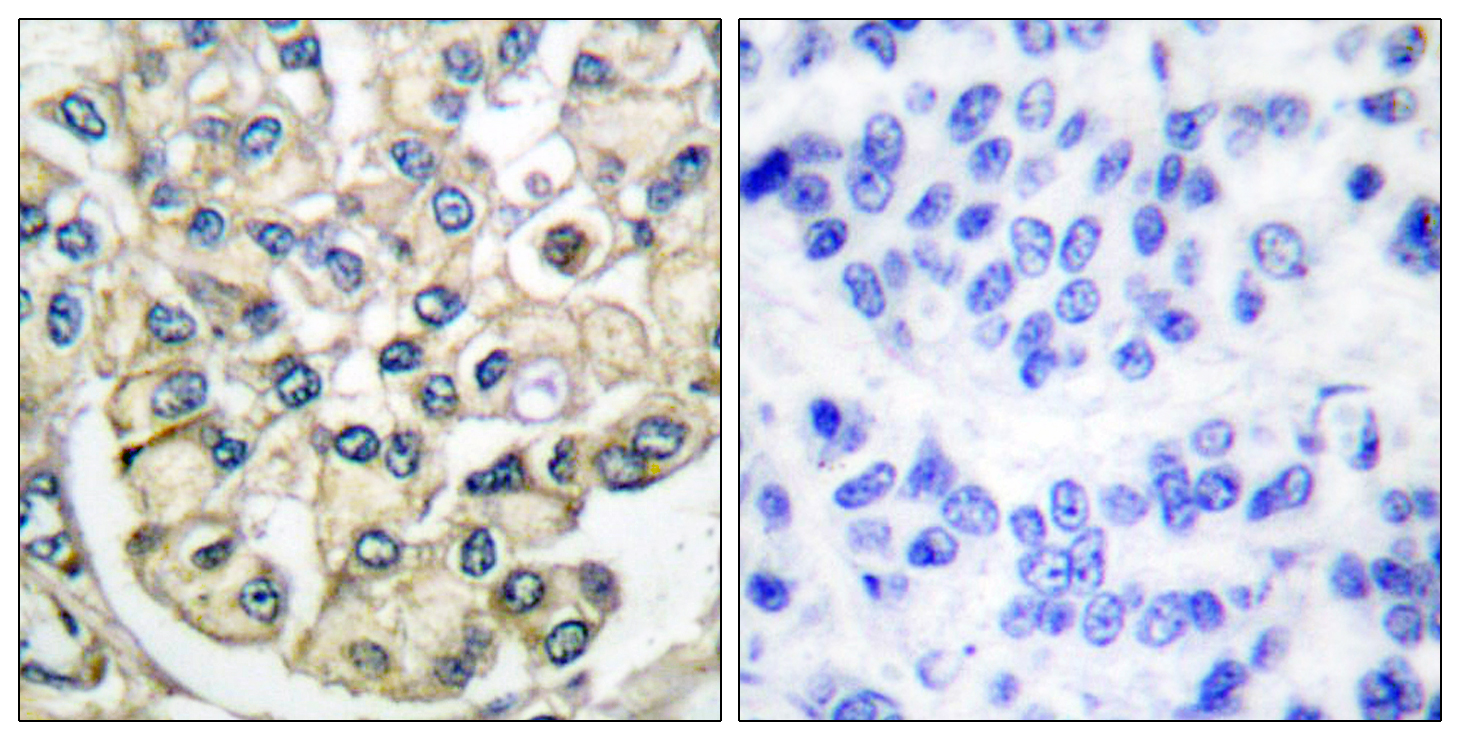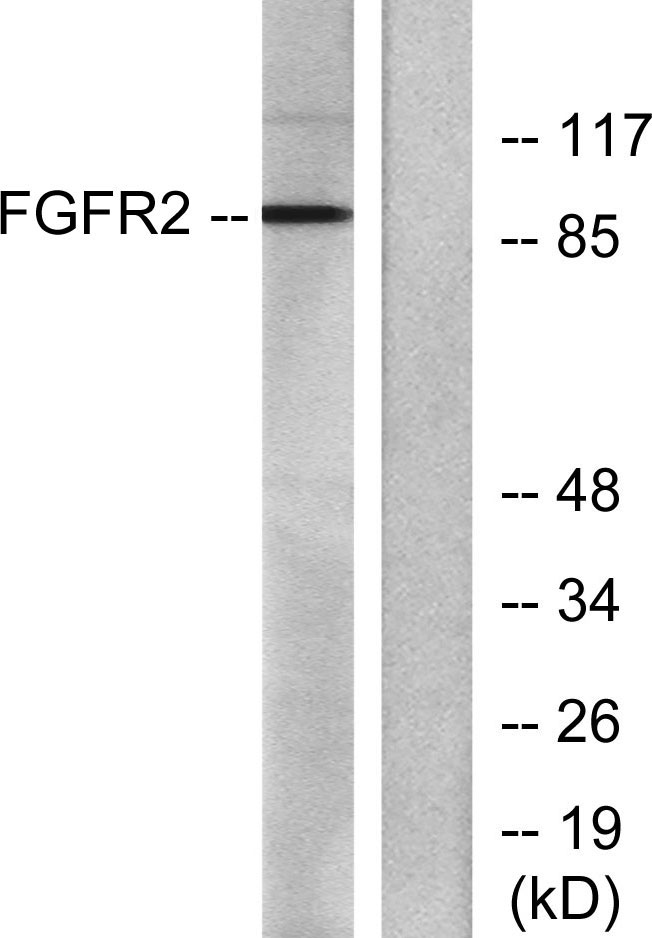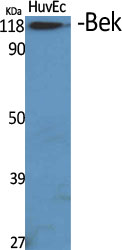产品名称
Bek Rabbit Polyclonal Antibody
别名
FGFR2; BEK; KGFR; KSAM; Fibroblast growth factor receptor 2; FGFR-2; K-sam; KGFR; Keratinocyte growth factor receptor; CD antigen CD332
蛋白名称
Fibroblast growth factor receptor 2
存储缓冲液
Liquid in PBS containing 50% glycerol, 0.5% BSA and 0.02% New type preservative N.
Human Gene Link
http://www.ncbi.nlm.nih.gov/sites/entrez?db=gene&term=2263
Human Swissprot No.
P21802
Human Swissprot Link
http://www.uniprot.org/uniprotkb/P21802/entry
Mouse Gene Link
http://www.ncbi.nlm.nih.gov/sites/entrez?db=gene&term=14183
Mouse Swissprot No.
P21803
Mouse Swissprot Link
http://www.uniprot.org/uniprot/P21803
免疫原
The antiserum was produced against synthesized peptide derived from human FGFR2. AA range:471-520
特异性
Bek Polyclonal Antibody detects endogenous levels of Bek protein.
稀释度
WB 1:500 - 1:2000. IHC 1:100 - 1:300. IF 1:200 - 1:1000. ELISA: 1:10000. Not yet tested in other applications.
宿主
Polyclonal, Rabbit,IgG
背景介绍
The protein encoded by this gene is a member of the fibroblast growth factor receptor family, where amino acid sequence is highly conserved between members and throughout evolution. FGFR family members differ from one another in their ligand affinities and tissue distribution. A full-length representative protein consists of an extracellular region, composed of three immunoglobulin-like domains, a single hydrophobic membrane-spanning segment and a cytoplasmic tyrosine kinase domain. The extracellular portion of the protein interacts with fibroblast growth factors, setting in motion a cascade of downstream signals, ultimately influencing mitogenesis and differentiation. This particular family member is a high-affinity receptor for acidic, basic and/or keratinocyte growth factor, depending on the isoform. Mutations in this gene are associated with Crouzon syndrome, Pfeiffer syndrome, C
组织表达
Blood,Brain,Cerebellum,Cornea,Mammary gland,Neonatal brain stem,Pla
细胞定位
Cell membrane; Single-pass type I membrane protein. Golgi apparatus. Cytoplasmic vesicle. Detected on osteoblast plasma membrane lipid rafts. After ligand binding, the activated receptor is rapidly internalized and degraded.; [Isoform 1]: Cell membrane; Single-pass type I membrane protein. After ligand binding, the activated receptor is rapidly internalized and degraded.; [Isoform 3]: Cell membrane; Single-pass type I membrane protein. After ligand binding, the activated receptor is rapidly internalized and degraded.; [Isoform 8]: Secreted.; [Isoform 13]: Secreted.
信号通路
MAPK_ERK_Growth;MAPK_G_Protein;Endocytosis;Regulates Actin and Cytoskeleton;Pathways in cancer;Prostate cancer;
功能
catalytic activity:ATP + a [protein]-L-tyrosine = ADP + a [protein]-L-tyrosine phosphate.,disease:Defects in FGFR2 are a cause of Apert syndrome (APRS) [MIM:101200]; also known as acrocephalosyndactyly type 1 (ACS1). APRS is a syndrome characterized by facio-cranio-synostosis, osseous and membranous syndactyly of the four extremities, and midface hypoplasia. The craniosynostosis is bicoronal and results in acrocephaly of brachysphenocephalic type. Syndactyly of the fingers and toes may be total (mitten hands and sock feet) or partial affecting the second, third, and fourth digits. Intellectual deficit is frequent and often severe, usually being associated with cerebral malformations.,disease:Defects in FGFR2 are a cause of Jackson-Weiss syndrome (JWS) [MIM:123150]. JWS is an autosomal dominant craniosynostosis syndrome characterized by craniofacial abnormalities and abnormality of the feet: broad great toes with medial deviation and tarsal-metatarsal coalescence.,disease:Defects in FGFR2 are a cause of lacrimo-auriculo-dento-digital syndrome (LADDS) [MIM:149730]; also known as Levy-Hollister syndrome. LADDS is a form of ectodermal dysplasia, a heterogeneous group of disorders due to abnormal development of two or more ectodermal structures. LADDS is an autosomal dominant syndrome characterized by aplastic/hypoplastic lacrimal and salivary glands and ducts, cup-shaped ears, hearing loss, hypodontia and enamel hypoplasia, and distal limb segments anomalies. In addition to these cardinal features, facial dysmorphism, malformations of the kidney and respiratory system and abnormal genitalia have been reported. Craniosynostosis and severe syndactyly are not observed.,disease:Defects in FGFR2 are a cause of Pfeiffer syndrome (PS) [MIM:101600]; also known as acrocephalosyndactyly type V (ACS5). PS is characterized by craniosynostosis (premature fusion of the skull sutures) with deviation and enlargement of the thumbs and great toes, brachymesophalangy, with phalangeal ankylosis and a varying degree of soft tissue syndactyly. Three subtypes of Pfeiffer syndrome have been described: mild autosomal dominant form (type 1); cloverleaf skull, elbow ankylosis, early death, sporadic (type 2); craniosynostosis, early demise, sporadic (type 3).,disease:Defects in FGFR2 are the cause of Antley-Bixler syndrome (ABS) [MIM:207410]. ABS is a multiple congenital anomaly syndrome characterized by craniosynostosis, radiohumeral synostosis, midface hypoplasia, malformed ears, arachnodactyly and multiple joint contractures. ABS is a heterogeneous disorder and occurs with and without abnormal genitalia in both sexes.,disease:Defects in FGFR2 are the cause of Beare-Stevenson cutis gyrata syndrome (BSCGS) [MIM:123790]. BSCGS is an autosomal dominant condition is characterized by the furrowed skin disorder of cutis gyrata, acanthosis nigricans, craniosynostosis, craniofacial dysmorphism, digital anomalies, umbilical and anogenital abnormalities and early death.,disease:Defects in FGFR2 are the cause of Crouzon syndrome (CS) [MIM:123500]; also called craniofacial dysostosis type I (CFD1). CS is an autosomal dominant syndrome characterized by craniosynostosis (premature fusion of the skull sutures), hypertelorism, exophthalmos and external strabismus, parrot-beaked nose, short upper lip, hypoplastic maxilla, and a relative mandibular prognathism.,disease:Defects in FGFR2 are the cause of familial scaphocephaly syndrome (FSPC) [MIM:609579]; also known as scaphocephaly with maxillary retrusion and mental retardation. FSPC is an autosomal dominant craniosynostosis syndrome characterized by scaphocephaly, macrocephaly, hypertelorism, maxillary retrusion, and mild intellectual disability. Scaphocephaly is the most common of the craniosynostosis conditions and is characterized by a long, narrow head. It is due to premature fusion of the sagittal suture or from external deformation.,function:Receptor for acidic and basic fibroblast growth factors.,similarity:Belongs to the protein kinase superfamily. Tyr protein kinase family.,similarity:Belongs to the protein kinase superfamily. Tyr protein kinase family. Fibroblast growth factor receptor subfamily.,similarity:Contains 1 protein kinase domain.,similarity:Contains 3 Ig-like C2-type (immunoglobulin-like) domains.,
纯化
The antibody was affinity-purified from rabbit antiserum by affinity-chromatography using epitope-specific immunogen.



.jpg)
